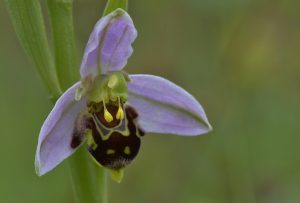Each winter, South Notts Local Group presents a programme of six monthly talks by a mix of wildlife experts and enthusiasts, who share their knowledge, experience and enthusiasm. Each year’s programme is varied, interesting and enjoyable, and the 20221/22 programme which concluded earlier this month was no exception. We learned about discovering wild flowers in Hampshire, encouraging butterflies in Derby, seeing big game in the Kruger National Park, finding places and wildlife in the Scottish Highlands, experiencing the flora and fauna of the Scottish Islands and helping hedgehogs in Oxfordshire.
In October, Gerald Ponting took us through the seasons in different habitats looking at the diverse flora to be found around his Hampshire home, ranging from road side verges to chalk downlands, by way of the Winchester South Park and Ride, and shared a fascinating mixture of plant name etymology, references to centuries-old herbals and extracts from Chaucer, Shakespeare and many more.
In November, Max and Christine Maughan reminded us that butterflies are not just beautiful, they are also important for our future: without them and fellow pollinators like bees, hoverflies and other insects, there will be no food. Our gardens are a vital source of pollen and nectar, so effective planting with easy to grow and maintain butterfly-friendly flowers and shrubs to give a flowering season from late winter to late autumn will attract and help sustain butterflies and many other insects.
In December, Barbara Meyer took us on safari in South Africa, mainly in the Kruger National Park, covering a wide mix of animals, including the ‘Big 5’ – a term coined by the hunting community to reflect that amongst all of the animals hunted, these were potentially the most dangerous, as “they can fight back” – lion, rhino, leopard, buffalo and elephant. Based on her extensive experience, Barbara’s advice on maximising your chances of seeing animals in South Africa was simple – use reputable organisations and experienced guides.
In January, Gordon Hamlett shared his experiences in writing a guidebook to the birdlife, wildlife and majestic beauty of the Scottish Highlands. It was a fascinating insight into his creative process in describing effectively such an enormous and diverse area, and some of the problems encountered in moving from idea to book, including: designer’s sleepless nights; proof reading; the difficulty of making location information useable, and the ethical issues around potential disturbance of birds, particularly rarer species.
In February, Nick Martin took us to Scotland’s Western and Northern Isles, bringing alive the different landscapes – brooding mountains; lochs, lochans and tarns; unbroken expanses of moorland; the glorious machair, bursting with all manner of wildflowers and the many bays and beaches, some of which would not look out of place on a tropical island. These all formed the background against which Nick described the abundant wildlife, from seals and otters through an incredibly wide and varied range of birds, large and small.
In March, Stephen Powle talked about hedgehogs, animals that have lived in Britain for around half a million years but which have in the last decade suffered a catastrophic decline, and which need all the help we can give them. Stephen offered a series of tips on how to help them, and went on to describe a community effort, led by his brother Chris, that has made a real difference in the Oxfordshire village of Kirtlington, including the creation of hedgehog-friendly spaces in gardens, school grounds and churchyard, all linked by a ‘Hedgehog Superhighway’.
Each talk was different, all were interesting and all were enjoyable, and it was both a pleasure and a privilege to engage with such knowledgeable and enthusiastic speakers. Using Zoom as the broadcast medium proved effective, allowing speakers to share many excellent and varied images, and dialogue between speakers and viewers. We all learned new things, including: how aspirin got its name; to beware baboons in a particular car park in the Kruger; to avoid riot police training on a Scottish nature reserve; if your tractor breaks down in the field, leave it and get another, and – perhaps most memorably – hedgehogs can climb stairs!
We are currently developing the 2022/23 Winter Wildlife Talks Programme, which promises to be equally varied, interesting and enjoyable, so please keep watching for an announcement on the Programme and booking arrangements here and on our Facebook page.

